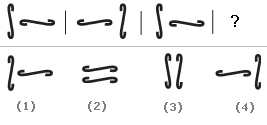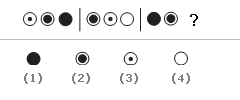Discussion
Home ‣ Logical Reasoning ‣ Logical Deduction See What Others Are Saying!
- Question
Statements: No man is a donkey. Rahul is a man.
Conclusions:
- Rahul is not a donkey.
- All men are not Rahul.
Options- A. Only conclusion I follows
- B. Only conclusion II follows
- C. Either I or II follows
- D. Neither I nor II follows
- E. Both I and II follow
- Correct Answer
- Only conclusion I follows
ExplanationSince on premise is negative, the conclusion must be negative. Conclusion II cannot follow as it contains the middle term. So, only I follows. - 1. Secretly is to openly as silently is to
Options- A. scarcely
- B. impolitely
- C. noisily
- D. quietly Discuss
- 2. Statements: All trucks fly. Some scooters fly.
Conclusions:
- All trucks are scooters.
- Some scooters do not fly.
Options- A. Only conclusion I follows
- B. Only conclusion II follows
- C. Either I or II follows
- D. Neither I nor II follows
- E. Both I and II follow Discuss
- 3. Statement: Nuclear power cannot make a country secure.
Courses of Action:
- We must stop further expenses on increasing our nuclear power.
- We must destroy our nuclear capability.
- We must concentrate on improving our diplomatic relations.
Options- A. Only I follows
- B. Only II follows
- C. Only III follows
- D. Only I and III follow Discuss
- 4. Statements: Prime age school-going children in urban India have now become avid as well as more regular viewers of television, even in households without a TV. As a result there has been an alarming decline in the extent of readership of newspapers.
Conclusions:
- Method of increasing the readership of newspapers should be devised.
- A team of experts should be sent to other countries to study the impact of TV. on the readership of newspapers.
Options- A. Only conclusion I follows
- B. Only conclusion II follows
- C. Either I or II follows
- D. Neither I nor II follows
- E. Both I and II follow Discuss
- 5. Look at this series: 544, 509, 474, 439, ... What number should come next?
Options- A. 404
- B. 414
- C. 420
- D. 445 Discuss
- 6. 3 8 13 18 23 28 33
Options- A. 39 44
- B. 38 44
- C. 38 43
- D. 37 42
- E. 33 38 Discuss
- 7. 2 8 14 20 26 32 38
Options- A. 2 46
- B. 44 50
- C. 42 48
- D. 40 42
- E. 32 26 Discuss
- 8. Look carefully at the sequence of symbols to find the pattern. Select correct pattern:

Options- A. 1
- B. 2
- C. 3
- D. 4 Discuss
- 9. Look carefully at the sequence of symbols to find the pattern. Select correct pattern:

Options- A. 1
- B. 2
- C. 3
- D. 4 Discuss
- 10. Middletown is north of Centerville.
Centerville is east of Penfield.
Penfield is northwest of Middletown.
If the first two statements are true, the third statement is
Options- A. true
- B. false
- C. uncertain Discuss
More questions
Correct Answer: noisily
Explanation:
Secretly is the opposite of openly, and silently is the opposite of noisily. Choices a and b are clearly not the opposites of silently. (Choice d) means the same thing as silently.
Correct Answer: Neither I nor II follows
Explanation:
Since the middle term 'fly' is not distributed even once in the premises, no definite conclusion follows.
Correct Answer: Only III follows
Explanation:
The statement asserts that increasing defensive power does not ensure the safety of a country. It is equally important to maintain good relations with other countries as well. But this does not imply that the country should stop concentrating on increasing defensive power or destroy the existing power. Thus, only III follows.
Correct Answer: Neither I nor II follows
Explanation:
The statement concentrates on the increasing viewership of TV. and does not stress either on increasing the readership of newspapers or making studies regarding the same. So, neither I nor II follows.
Correct Answer: 404
Explanation:
This is a simple subtraction series. Each number is 35 less than the previous number.
Correct Answer: 38 43
Explanation:
In this simple addition series, each number is 5 greater than the previous number.
Correct Answer: 44 50
Explanation:
This is a simple addition series, which begins with 2 and adds 6.
Correct Answer: 4
Explanation:
Look for opposites in this series of figures. The first and second segments are opposites of each other. The same is true for the third and fourth segments.
Correct Answer: 3
Explanation:
In this series, the shaded part inside the circle gets larger and then smaller.
Correct Answer: false
Explanation:
Because the first two statements are true, Penfield is west of Centerville and southwest of Middletown. Therefore, the third statement is false.
Comments
There are no comments.More in Logical Reasoning:
Programming
Copyright ©CuriousTab. All rights reserved.
